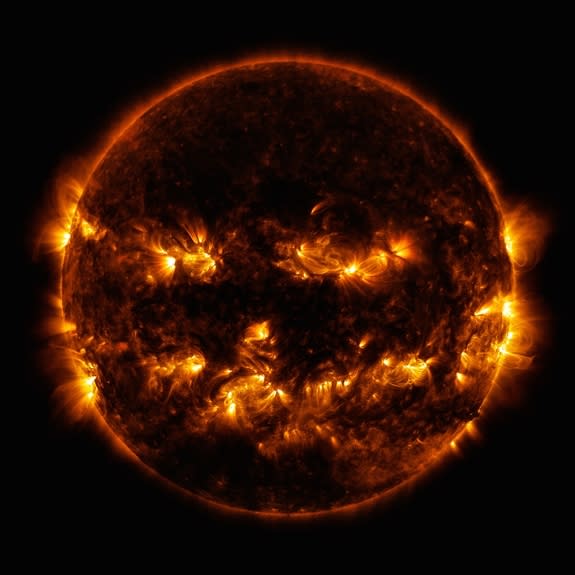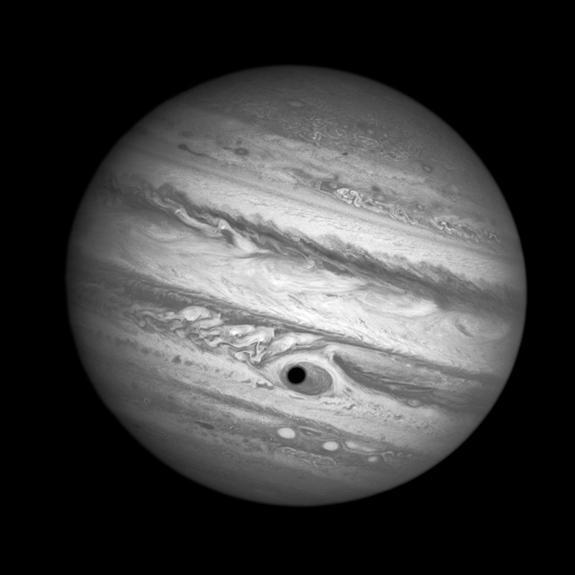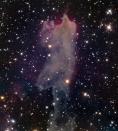5 Spooky Space Views for Halloween
Outer space can be a spooky place.
Halloween on Earth usually brings out the ghouls and werewolves in neighborhoods around the United States, but what are some of the most unsettling sights in space? From mysterious alien planets to ghostly nebulas, the universe is filled with oddly shaped objects that let the imagination run wild.
In honor of Halloween, here are five of Space.com's favorite creepy space images:
The witch's head
The appropriately named Witch Head Nebula truly looks like a witch screaming out into the void of space. The conjurer even has green skin, a crooked nose and a pointy chin in this photo taken by NASA's Wide-Field Infrared Survey Explorer (WISE) and release on Halloween 2013. (The witch is turned sideways in the image.)
If you want to try to spot the Witch's Nebula this Halloween, look to the constellation Orion's "knee" to possibly spot the cosmic witch. The nebula itself is hundreds of light-years from Earth.
Jack-o-lantern sun
Halloween came early on the sun this year. Earth's closest star took on a frightening look in an composite image taken by NASA's Solar Dynamics Observatory in early October. Active regions of the star glow in a pattern that make's the sun look like it sprouted two eyes, a nose and a mouth like a jack-o-lantern.
"The active regions in this image appear brighter because those are areas that emit more light and energy," NASA officials said in a statement. "They are markers of an intense and complex set of magnetic fields hovering in the sun’s atmosphere, the corona." [See space-themed pumpkins]
Galaxy's 'ghost light'
The Hubble Space Telescope has seen the light of stars blown out from galaxies that were destroyed billions of years ago. A picture release Thursday (Oct. 30), shows a cluster of 500 galaxies located about 4 billion light-years from Earth.
Stars orphaned from their original galaxies create the ghostly blue glow of starlight in the image. The stars now wander between galaxies in the cluster, according to NASA.
"The Hubble data revealing the ghost light are important steps forward in understanding the evolution of galaxy clusters," Ignacio Trujillo of The Instituto de Astrofísica de Canarias (IAC), Santa Cruz de Tenerife, Spain said in a statement. "It is also amazingly beautiful in that we found the telltale glow by utilizing Hubble’s unique capabilities."
Spooky nebula
A purple and blue-hued nebula shines in the Milky Way. The nebula (named LBN 483) looks like a wisp of smoke flying high into the universe.
"Obviously this object is a good seasonal pick with the scary nights ahead," astrophotographer Adam Block said of his image. "The cloud of dust glows eerily both from scattered starlight and extended red emission due to the radiation of some nearby star. My mind alternates between something dancing in ecstasy or writhing in torture. Either way... very spooky..."
Jupiter's eye
A moody, new photo of Jupiter shows the planet's distinctive eye looking more like an actual eye than usual. The Hubble Space Telescope took this picture of Jupiter in April when the gas giant's moon Ganymede passed over the planet's eye, casting a shadow on the huge storm.
"This [Ganymede's pass] gave the giant planet the uncanny appearance of having a pupil in the center of a 10,000 mile-diameter 'eye,'" NASA officials said in a statement.
Follow Miriam Kramer @mirikramer and Google+. Follow us @Spacedotcom, Facebook and Google+. Original article on Space.com.
Copyright 2014 SPACE.com, a TechMediaNetwork company. All rights reserved. This material may not be published, broadcast, rewritten or redistributed.

 Yahoo News
Yahoo News 










